Lijiang and Shangri-La
Exploring the Naxi culture in the Southwest of China
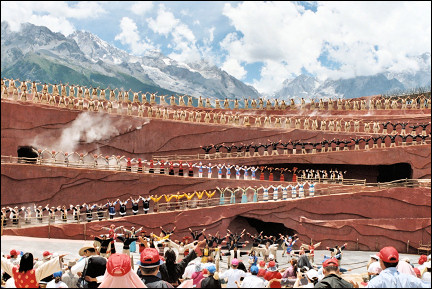
|
The landscape and culture of the Lijiang and Shangri-La prefectures of the Yunnan province in the Southwest of China draw visitors from everywhere. Both are home to peoples whose cultures reflect closeness to the land and a deep spirituality. In Lijiang, the matriarchical Naxi culture is the focus of this trip.
Travelogue & photos: Michelle Spaul
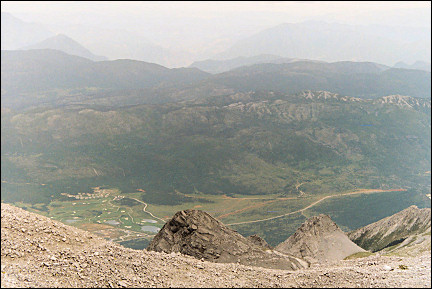
|
The Naxi travelled from the Northwest to the Southwest of China many centuries ago. They absorbed the religions and cultures they met on the way. This skill of adaptation helped ensure their survival. The story of this journey forms the basis of their mythology.
My trip to Lijiang was made possible by a team meeting being held in China. Lijiang was selected, as few of us - British or Chinese - would get a chance to visit there otherwise.
Lijang
Chicken claws and a singing contest
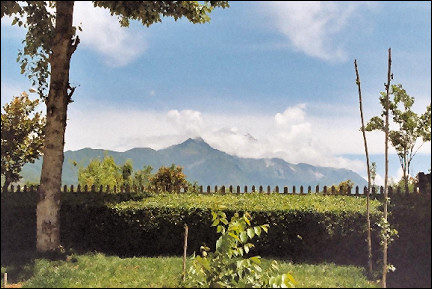
|
Our hotel; the Guan Fang Garden, is situated between the Bayan and Shuhe old towns. It is new and built in traditional house-and-courtyard style. It enjoys views of the Jade Dragon Snow Mountain.
In the evening we visited Shuhe Old Town for dinner; my first introduction to real Chinese food - chicken claws and all - and the hospitality of the Chinese.
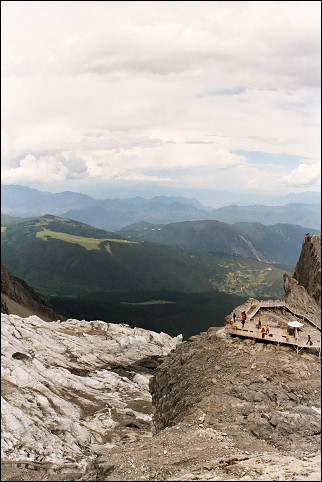
|
Next day, after work, we went for dinner in Bayan Old Town. We ate in the main street of restaurants and were treated to a singing contest. Traditionally dressed women sang a few lines of song and then challenged others to sing back.
Given the right audience - and the ability to create insulting, rhyming couplets in Chinese - this promised rowdy entertainment. Not understanding Chinese, however, I headed home with a couple planning to get an early night.
The idea of a massage came up and we were driven around the new town, looking at massage parlours. The first two were too "upmarket." The third attempt took us to the back stairs of a building, to a place that appeared to let rooms by the hour.
The fourth stop brought us what we were looking for and soon we relaxed during foot and full body (clothed) massages. My masseur was blind, which is said to make excellent, intuitive masseurs.
Jade Dragon Mountain
The highest peak is sacred to the Naxi
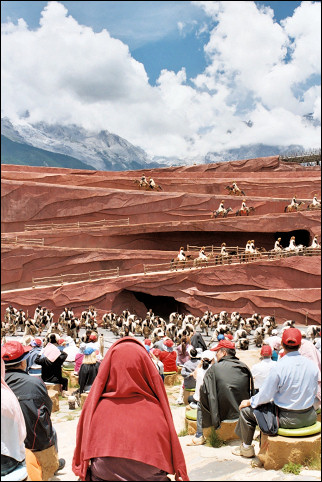
|
On the afternoon of our second day in Lijiang several of us visited Jade Dragon Snow Mountain. It is technically Himalyan, though it is a long way from home.
While Lijiang is mostly known for the Naxi people, there are over a dozen minorities (non-Han Chinese) living in Lijiang Prefecture. Their cultures are celebrated in a moving show.
After song, dance and horse riding with a commentary in Chinese (English subtitles), the audience is invited to join in a series of prayer movements to the Jade Snow Dragon Mountain. After the show one can pray under the mountain with attending Dongbas (Naxi shamans).
The only transportation in the tourist zone is the "green bus." This reduces traffic, noise and pollution.
Our destination is the top of one of the thirteen peaks of the mountain - the highest peak is sacred to the Naxi and we were told that it has never been climbed. A bus took us to a modern visitor's centre part-way up and a cable car took us from there (3000 m) to an altitude of 4680 m.
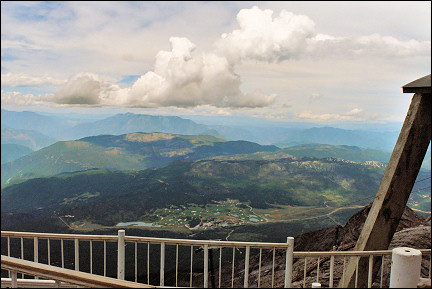
|
At this altitude, in the heights of a "snow mountain," rain and snow are frequent and the air is thin. One can rent warm jackets and oxygen bottles at the main visitors centre.
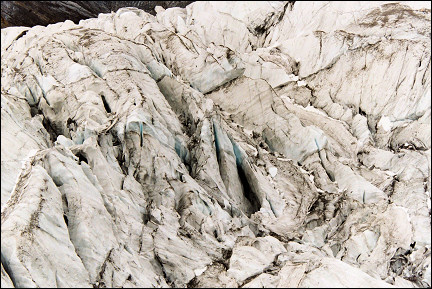
|
Last, we visited the White Water River. We thought the name referred to the cloudy glacial waters, but it comes from the polished limestone and marble that form the riverbed. Farming is the main source of income here and yaks are a common sight.
It is possible to ride a yak for a fee, which farmers charge in accordance with the apparent wealth of the tourist.
Yangtze River
The "rafting" is not for adrenalin junkies
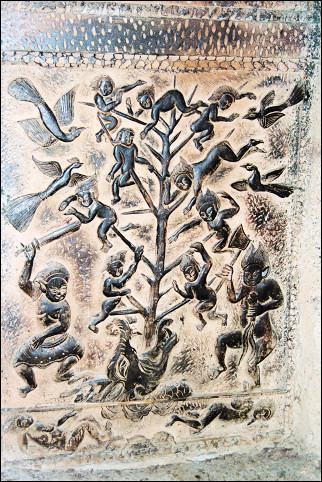
|
After the work meetings I'd planned a holiday. On the first day I met my guide and driver. As we drove through Lijiang and out towards the Yangtze River, there were modern buildings nestled with the traditional; cranes lifted concrete blocks casting shadows over artisans placing pan tiles on roofs, and motorised traffic hustled with bicycles and rickshaws.
We stopped at a collection of small temples clinging to the side of a valley. Here I was told about the James Hilton book "Lost Horizon," which introduced Shangri-La to the world. Shangri-La's location has been debated for over seventy years; for some it is in Yunnan, either in Lijiang or the town of Zhongdian, renamed Xianygela or Shangri-La.
Before arriving in Shangri-La we stopped twice, first in the town of Stone Drum (Shigu) on the first bend of the Yangtze river. It is said that the first bend is the cradle of Chinese civilisation, as without it the southern Chinese cities, including Shanghai, would not have had enough water to thrive.
After a walk through the old town we took a path through a peaceful, wooded park to a large building that houses a rafting company.
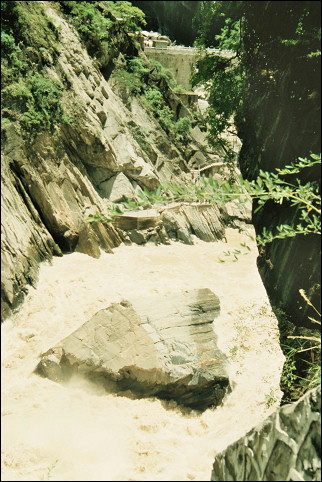
|
There were several Chinese tourists waiting for boats. While I was in China, it hardly rained and yet most tourists were holding umbrellas to protect themselves from the sun, which is harsh at this altitude. Despite this excellent reason, it was hard to hide my amusement when burly men walked past with umbrellas decorated with little pink rabbits.
After my guide undertook the normal Chinese courtesies and confusions, we "drifted." This is a bit of a misnomer as the rafts were powered; this is not a trip to thrill adrenalin junkies, but an opportunity to take in the splendid panorama of the river with its small holdings and miniscule cultivated terraces clinging to the sheer hillsides.
We landed on a small island that is even smaller during the spring melt. I can't begin to imagine the impact of the Three Gorges Dam on this area and am glad that I saw it in its natural state.
The second stop was at Tiger Leaping Gorge. My new guide (they can only work in their own prefecture) told me the Tibetan story of the daughters and sons of the wind and rain gods. This myth tells how the youngest daughter - the Yangtze River - ran away to marry the dragon prince of the East, and the sons’ – Jade Dragon Snow Mountain and Haba Snow Mountain - attempt to stop her. They failed, because she ran below their skirts, between them, thus creating the Tiger Leaping Gorge.
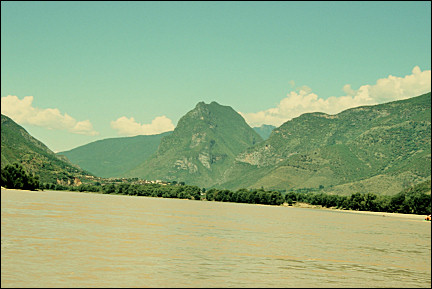
|
The visitors centre for the gorge gives access to a steep trail down the side of the Haba Snow Mountain and a boardwalk providing a viewing point for the narrowest part of the gorge (30 metres).
Shangri-La
During breakfast, the hotel staff performed Tai Chi
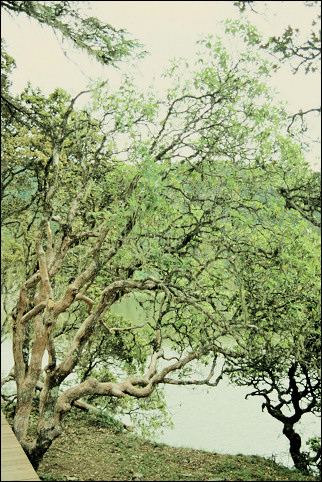
|
Because of problems with the car we arrived late in Shangri-La. There wasn't enough time to go to the Songzanglin Temple. This is reputed to be the largest Tibetan Buddhist monastery in China.
Instead, we walked to the top of the old town and visited a temple with a large prayer wheel. It was different from the ones I visited in the Lijiang prefecture, as there was no Naxi influence.
Instead, the wheel of life, the seven realms of heaven and earth and the traditional white Tibetan scarfs of welcome, good luck and thanks were the religious objects as well as decoration of the temple.
During breakfast, the hotel staff performed Tai Chi or Chi Gong in the car park. We drove to the Pudacuo National Park and again had to catch buses to get around. The park is the home of the Bita Lake and over 200 species of azalea.
We got off at the first bus stop - as did many others, but when they realised that the only option was to walk, most got back on. We walked down to a deck by the Bita lake and watched fish jumping, then we took a boardwalk around the lake.
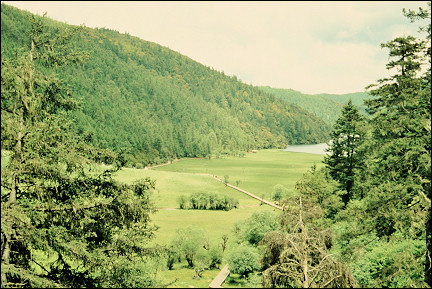
|
After a second bus journey we walked to a boat and took a leisurely ride along the lake. Our final boardwalk took in the end of the lake, marsh areas, which are lake - the Shudu Lake - for much of the year and then meadow land that only floods occasionally.
Lijiang
Tasting fifty-year-old Pu-erh tea
After lunch in Shangri-La we set off on the long drive back to Lijiang. We passed large houses with three stories; the animals live on the open ground floor.
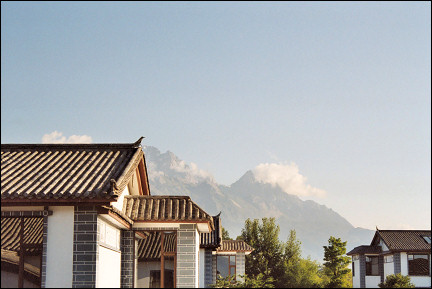
|
The Buddhist symbol is a common decoration and is easily mistaken for the swastika, especially because it is used both in its Buddhist orientation and its mirror image, the swastika.
I checked into the Lijiang Ancient Town Hotel, on the edge of the Bayan Old Town, close to a landmark water wheel. The hotel is built in traditional Naxi style, one courtyard and four halls.
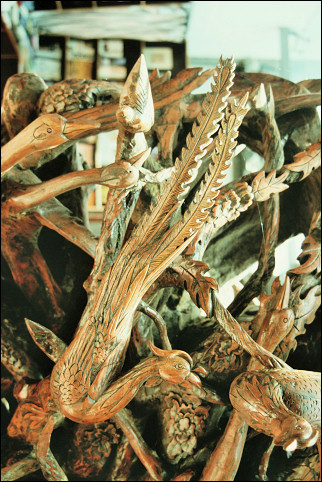
|
After a brief rest, I had dinner with my guide, then visited a teahouse just off the old market square. I had so much tea that I was light headed, but it was worth it to taste fifty-year-old Pu-erh tea and local teas, including White Snow tea.
This tea is unique to the Jade Dragon Snow Mountain and its flavour "comes back" when another liquid is drunk.
Lijiang is often compared to Disney World, because of the many tourists and the changes made to attract even more.
Dayan and Shuhe Old Towns have been rebuilt. But Naxi people still live in Dayan, and Shuhe is home to many minorities who practice trades such as silversmithing, batik manufacture and silk production.
Also, tourism supports many people and helps fund the preservation of their town and culture. The conversion of houses to shops, restaurants and hotels has been halted by recent ordinance.
Our first stop this day was the park of the Black Dragon Pool.
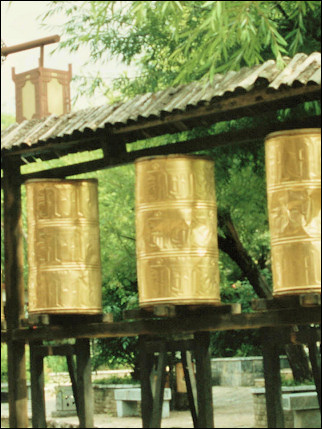
|
The water in the pool flows from the slopes of the Jade Dragon Snow Mountain. It has the House of the Seven Phoenixes - a transposed gate house from a former Buddhist temple - and the Dongba museum and school, in which pictograms describe Naxi myths and an artisan makes traditional Dongba paper.
In the restored Shuhe Old Town, it's great wandering; I enjoyed the artisan shops selling crafts from the local cultures and the many temples, bars and restaurants.
After crossing a bridge, I explored the other part of the old town, with shops, restaurants and hotels in a few light and lively streets. On the way back to the old town the tea museum is worth a visit - if only to see the picture of pack horses being pulled across the Yangtze on a single rope "bridge."
Dongba Valley
A bicycle trip on safe roads
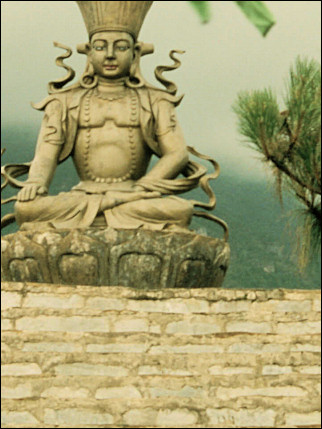
|
Today we went bicycling; we picked up our bikes from a square with a giant Chairman Mao statue. It took some time to pick a bike that was comfortable and had working brakes, but then we set off on the 12 km journey to Dongba Valley.
The road was safe; while the Chinese driving style is very different to that in the UK, respect for other road users seems to be high.
The many cyclists travelling in the wrong direction were warned with a friendly toot of the horn that a vehicle was approaching.
The Dongba valley is the home and livelihood of Naxi people. Traditional houses of Naxi and other peoples are open to visit.
The walk along the lake on the edge of the forest - another boardwalk - is worth taking and passes a cemetery with memorials for extinct species, giving the name of the animal, the date of death of the last member of the family and the cause of extinction.
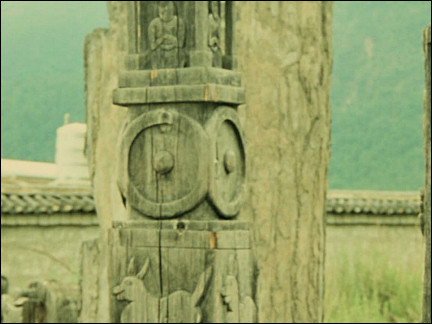
|
If I had to cut one part of the trip it would have been Dongba valley, as I don't like visiting people as if they are museum pieces.
We then embarked on the next leg of the bike ride, with a more serious incline, to the Jade Water Village - en route we visited the 'Road to Heaven'.
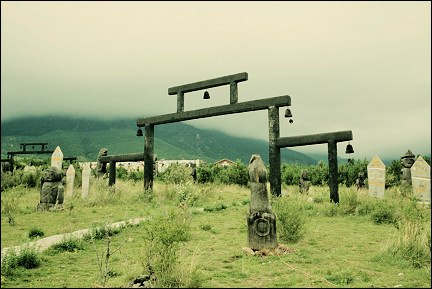
|
The Road to Heaven is a tranquil spot; its main feature is a long, colorful floor mural, showing the three realms: hell, earth and heaven, of the Naxi religion. On the right, sculptures represent good spirits and gods; evil spirits are depicted on the left.
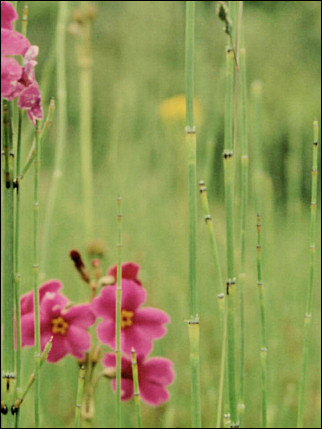
|
At the top of the road is a small hermitage and a set of temples with huge Buddha and Naxi Guides statues, but my favourite was the walk back down through the peace garden. This is a set of glades and paths filled with wind chimes. The temples and garden face the holy Jade Dragon Snow Mountain.
We walked a little further upward to the Jade Water Village. Built by a local wealthy man to preserve the Naxi/Dongba culture, this is a peaceful mix of museum, gardens and a holy water spring (the water source for Lijiang). Here I bought a stone seal, a representation of the Naxi guardian angel and a carved dragon. While the prices were higher than haggling would achieve in the old town, I liked that the profits are put back into the centre.
The remainder of the journey was, thankfully, down hill, stopping to breathe in the splendour of the view.
Yufeng Temple and Baisha
A monk rescued the camelia trees
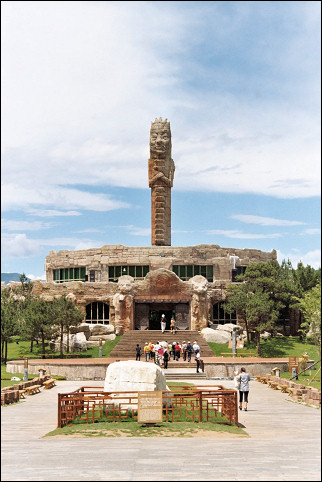
|
The Yufeng temple with its prayer wheels, frescoes, Buddhas and gardens is beautiful. It has a pair of camelia trees, fused together to form the 'tree of 10,000 blooms' - so called because they have about 1000 flowers between them and during the blossoming season each flower blooms 10 times. The age of the trees is said to be anything from 600 years old (Ming dynasty) to a mere three centuries. The tree was cited for destruction during the Cultural Revolution, but was rescued by a monk - who said that the purpose of his life was to save the tree.
Immediately below the tree is a well-preserved Naxi mosaic. Made up of dark and light pebbles, this mosaic is similar in style to many in the area. The central motif is the symbol of longevity, bordering this are bats - a totem animal for the Naxi. This is common to many mosaics, but here the bats are almost like butterflies.
Leaving the temple, we cycled into the heart of this poor town, the third of Lijiang's old towns, Baisha. This was the second home of the Naxi people.
Leaving Baisha we had to stop to allow about fifty cows to pass on their journey home from the field with a local herdsman. I was amazed to watch three of these huge and majestic beasts enter a house. The cowherd told us that the herd was a collection owned by about 20 families. Closer examination of the house showed an ornate gatehouse breaking a high-walled enclosure around a house and several outbuildings.
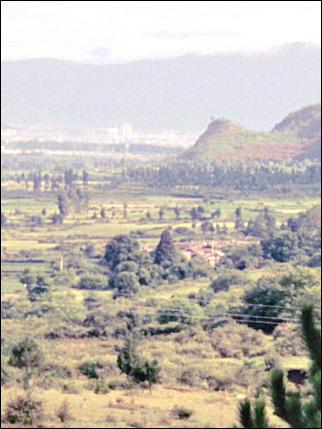
|
Continuing our ride we passed farm workers heading home. In true Naxi style, they carried large woven baskets on their backs and tools for harvesting their crops and preparing the land - all were women.
It was nice to get back and drop off the bike. I went to explore the new town with the goal of finding the massage parlour I visited the previous week. It was interesting: chain stores nestle with bootleg video stores, herbal stores and shops that sell everything.
I found a wonderful bookshop and bought Harry Potter and the Philosophers Stone in Chinese for my guide and a book in English on the history of China. In a department store I stared in wonder at the array of pickled insects - I had only seen "fresh" dragonflies to this point.
Laishi Lake
Horse-back riding and boating
Another early start. We drove towards the Yangtze, stopping at Laishi Lake. The lake provided another example of the extremes in water level between the seasons. It was at its lowest and littered with white nets of fishermen. The rich meadowland around the lake supports cows, yaks, water buffalo and horses and nearby fields support over 7000 families.
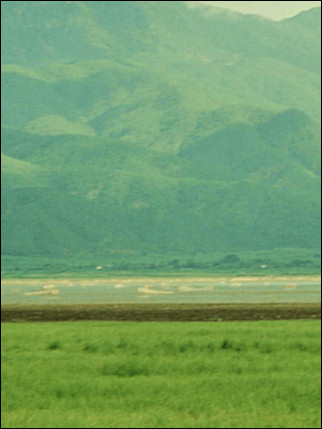
|
The Naxi love their horses; strong and able to negotiate the tea-roads carrying heavy loads, these graceful, small beasts are generally strong minded and temperamental. For example, three horses cannot be left alone together, as they will fight.
My horse, however, was reliable. I could ride him without recourse to the guide and had to really kick and shout to make him gallop. The ride was fun, comprising easy riding to take in the views and ask questions, interspersed with hard riding to cover ground.
The return ride was much shorter, as we stopped to journey across the lake by boat. Our boatman punted us across the lake; he was a fisherman and dressed in a three piece suit and brogues. Part way across, we stopped to buy barbecued fish from a man in a wooden canoe; the fish were cooked over coals held in an old paint can.
After the boat trip we walked back to the tour centre and crossed a field full of caterpillars - literally hundreds of animals to each square metre.
Mu Mansion
A stunning example of Chinese architecture
From Laishi Lake we travelled back to the old town and walked to the Mu Mansion. The Mu family was the head family of the Naxi people for centuries. The only one of three sons who did not oppose Kubla Khan when he invaded in the twelfth century founded the family after being rewarded with ruling power over the region.
The Emperor of China assigned the name Mu when the family built relationships with the Han people, adopting their calligraphy and assimilating cultural and religious aspects into their own traditions.
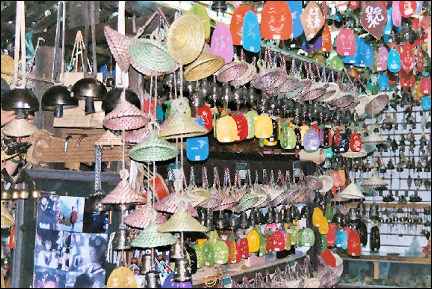
|
The Mu mansion is a stunning example of Chinese architecture, with wonderful gardens and an outdoor art gallery, a concert hall with Naxi classical music playing and several buildings preserved to show how the family lived. The top of each building has a view of the old town and the surrounding valley.
After this visit my guide helped me buy wind chimes. As each chime has some form of blessing or prayer in both Chinese and Dongba pictography, getting the right message for my family and friends was important.
Yak Meadow
Walking around Jade Dragon Snow Mountain
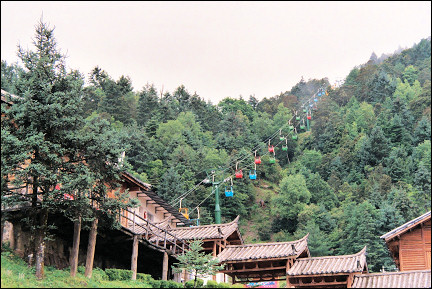
|
Next day I headed to the Sleeping Lion hill to explore the gardens and the Wenchang palace. At the head of the old town, the palace is visible from several places and is well lit at night. The bottom of the gardens butts up to the Mu Mansion gardens and gives another splendid view, as does the climb to the top of the palace.
Before heading to China I wanted to hike through the Tiger Leaping Gorge. In retrospect, I am glad this didn't happen as I found the gorge too hot on my brief visit.
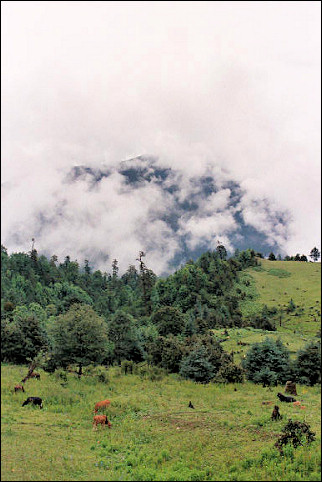
|
However, I wanted to walk. We headed to another part of the Jade Dragon Snow Mountain tourist zone and took an early bus to the smallest of three cable car lines for a short journey to Yak Meadow. The bus passed the White Water river and headed up through a small town, passing homes and farms of local people.
The cable car travelled over wooded areas and through a small valley of absolute calm. The cars are open and passengers are encouraged to be silent to ensure everyone can enjoy the peace. There is a Tibetan Buddhist temple near the cable car station and slightly off the main walk.
Outside the boardwalk, the land is grazed by yaks; inside the boardwalk, there is a profusion of wild flowers. I was bitten by a leach that had made its way into my glove, my wound bled for ages, but I got little sympathy from my guide and driver!
The walk was stunning with the Jade Dragon Snow Mountain coming out of the clouds just as we walked below it; local legend has it that the mountain only appears for Very Important People... At the end of the walk was the ubiquitous barbecue with a variety of meats, tofu and wild flowers cooked on skewers - the flowers were delicious.
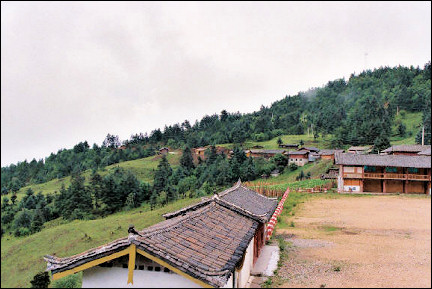
|
Back at the tourist zone we visited a herbal medicine market - the largest in the prefecture. The variety of medicinal items - from every part of many plants, to deer tendons, to black ants - is staggering and I picked up some rose oil and herbal toothpaste.
I spent a relaxing afternoon in Lijiang old town. I had bought too much to take home in my luggage and set out to buy a carry-on bag. I left with a canvas bag with Dongba embroidery and a workbag made from yak skin.
Last day in Lijiang
A spa with hot water from a subterranean lake
I was keen to spend my last day relaxing in a spa. My guide offered two and I took the one in the lea of Paint Brush Hill.
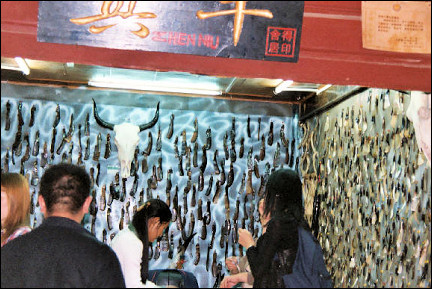
|
The hot water in the spa is from a subterranean lake, which was uncovered during excavations to find out what causes the earthquakes that occur in the region. Some of this water is now pumped to the surface to supply a complex of outdoor pools and personal hot tubs.
For a tiny sum I rented a room for the day, enjoyed my own bath and the outdoor pools, taking in the fresh air, bird song and mountainous backdrop. The full-body massage I took, included a petite masseuse walking down my spine and sitting on my bottom, pummelling my back with her feet. For days, my energy levels were high - even with my dreadful travel connections.
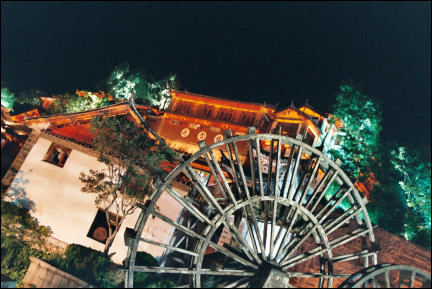
|
I spent my last night wandering the old town, eating and drinking and taking evening shots, without the aid of a tripod.
Leaving Lijiang was hard, there is so much more to explore, experience and understand.